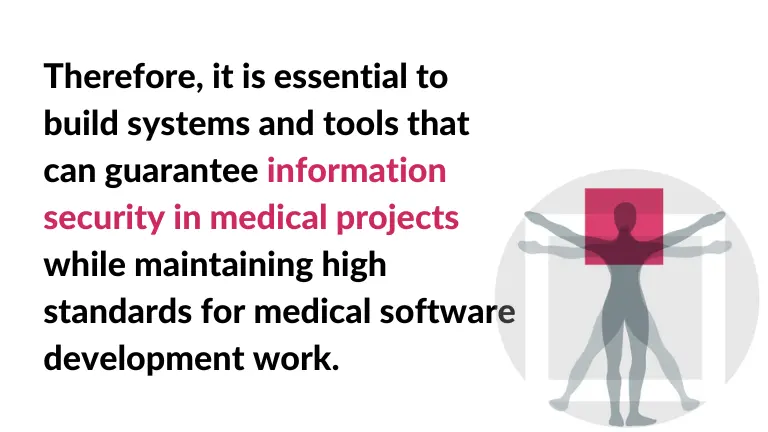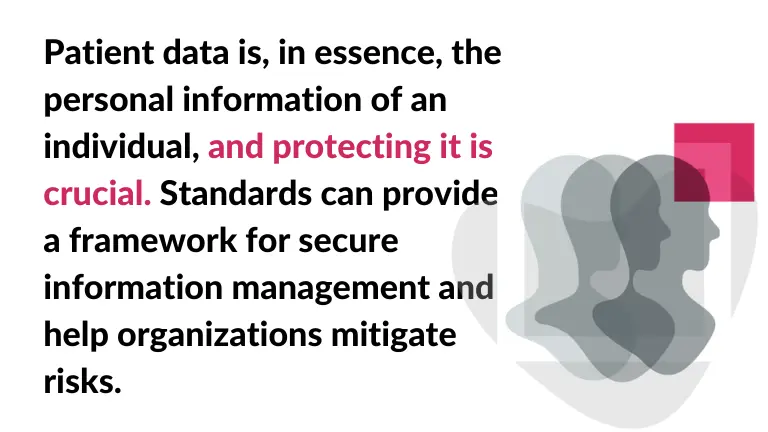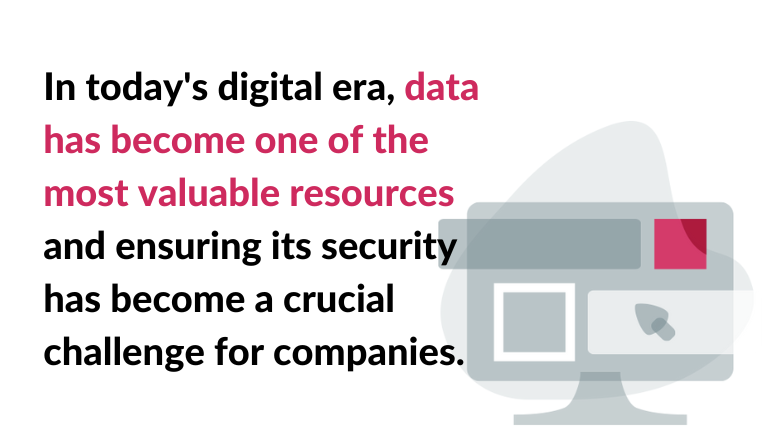Information security in medical software
The importance of standards in the development of software as a medical device. This was a topic discussed in a previous post. In addition to the well-known ISO 13485, I described other standards that can help improve the quality and safety of these devices. In this context, we mentioned IEC 62304, ISO 14971 and ISO 9001.
However, the topic of standards related to medical software development is an extremely complex issue that we cannot exhaust in a single text.
This time we will focus on a group of standards that are critical to information security in medical software development. We’ll look at standards that help protect both image and non-image data. We will bring back the well-known ISO 9001 standard and a standard focused on information protection – ISO 27001 Information Security Management System.
Information security and technology development
Medical software, including medical imaging software, is vital for accurate diagnosis, treatment planning, and patient care. However, with the growing use of digital health solutions, it is becoming increasingly important to have robust information security measures in place to safeguard sensitive patient data. Therefore, it is essential to build systems and tools that can guarantee information security in medical projects while maintaining high standards for medical software development work.

Attention: High Risk!
Medical software used for processing both imaging and non-imaging medical data in medical devices can be susceptible to hacking attacks. A report by SOPHOS, “The State of Ransomware in Healthcare 2023” provides an example of such data vulnerability. “The 2023 survey revealed that the rate of ransomware attacks in healthcare has decreased from 66% to 60% year over year. Even though the rate of attack in the 2023 study has dropped, it is almost double the 34% reported by the sector in 2021.
The rate of data encryption following a ransomware attack in healthcare was the highest in the last three years: 73% of healthcare organizations reported that their data was encrypted in the 2023 report, up from 61% in the 2022 report and 65% in the 2021 report.
In more than one-third of the attacks (37%) where data was encrypted, data was also stolen, suggesting that this “double dip” method (data encryption and data exfiltration) is becoming commonplace.”[1]
Healthcare organization manages sensitive data
This is an example of the danger posed by cyberspace for information security in medical projects. As we have access to patient data, including both images and non-images, we must prioritize its security. Patient data is, in essence, the personal information of an individual, and protecting it is crucial. Standards can provide a framework for secure information management and help organizations mitigate risks.
It’s important to note that medical software used in processing medical data, whether imaging or non-imaging, can be prone to hacking attacks. A report by SOPHOS titled “The State of Ransomware in Healthcare 2023” provides an example of the vulnerability of such data. Therefore, we must be wary and take necessary precautions to prevent such risks.

ISO 27001 refers to secure information
Two standards can help: ISO 9001 and ISO 27001 Information Security Management System. Although ISO 27001 and ISO 9001 focus on different aspects of management, they can complement each other, especially in the context of information protection.
Secure your medical project – a leak-proof system will help
-
ISO 27001, Information Security Management System
According to https://www.iso.org, ISO 27001 is a globally accepted standard that provides guidelines to manage and maintain information security systems effectively. This comprehensive framework aids organizations in setting up, implementing, maintaining, and continually improving their information security management systems. By adhering to this standard, organizations can ensure the confidentiality, integrity, and availability of sensitive data.
In today’s world, cybercrime is on the rise, and new threats are emerging every day, making it challenging to manage cyber-risks. However, ISO/IEC 27001 can assist organizations in becoming more risk-aware and proactively identifying and addressing weaknesses. This standard promotes a holistic approach to information security by vetting people, policies, and technology. Implementing an information security management system based on this standard can serve as a tool for risk management, cyber-resilience, and operational excellence. [2]
-
ISO 9001, Quality Management System
ISO 27001 is a globally accepted standard that provides guidelines to manage and maintain information security systems effectively. This comprehensive framework aids organizations in setting up, implementing, maintaining, and continually improving their information security management systems. By adhering to this standard, organizations can ensure the confidentiality, integrity, and availability of sensitive data.
In today’s world, cyber-crime is on the rise, and new threats are emerging every day, making it challenging to manage cyber-risks. However, ISO/IEC 27001 can assist organizations in becoming more risk-aware and proactively identifying and addressing weaknesses. This standard promotes a holistic approach to information security by vetting people, policies, and technology. Implementing an information security management system based on this standard can serve as a tool for risk management. Moreover, it can be the solution for cyber-resilience, and operational excellence. [3]

Information security and areas that we protect
In today’s digital era, data has become one of the most valuable resources and ensuring its security has become a crucial challenge for companies. The International Organization for Standardization (ISO) has provided a framework to ensure effective data protection.
- ISO 27001 standards specify a range of access control, data encryption, and physical security requirements. All these requirements help protect patient data from unauthorized access, disclosure or alteration.
- The ISO standard helps organizations identify and assess information security risks. Thus, it enables them to implement appropriate safeguards to prevent breaches and security breaches.
- Moreover, many data protection regulations, such as RODO, require organizations to implement an ISO 27001-compliant Information Security Management System to meet regulatory requirements.
Standards in information security in a medical project – summary
ISO 9001 and ISO 27001 focus on different aspects of organizational management. But their implementation can complement and reinforce each other. Especially in the context of information protection. By implementing an integrated management system, organizations can achieve many benefits. Implementing information security and quality management systems can help companies build customer trust. Moreover, it helps minimize risks and contributes to developing innovative healthcare solutions.
References: